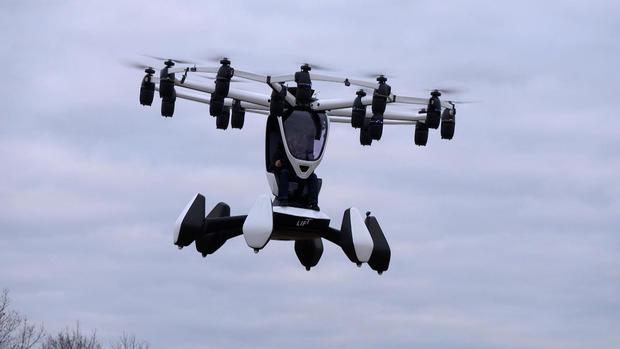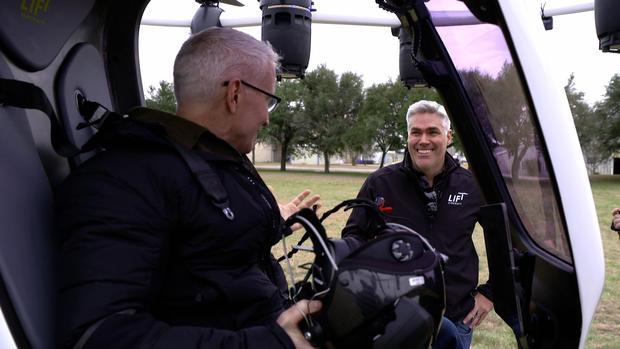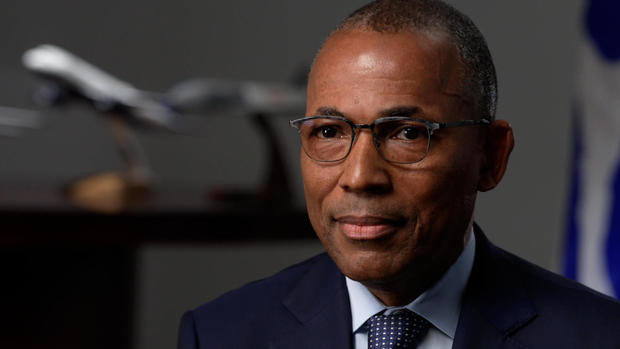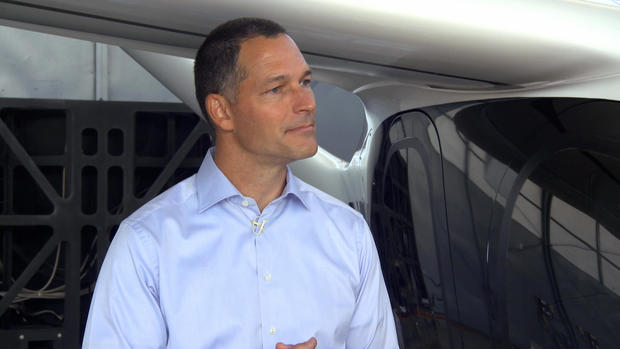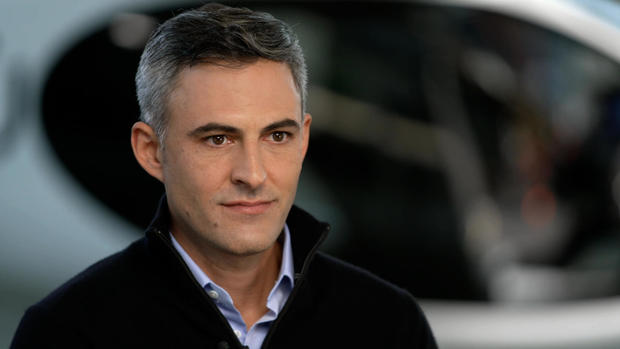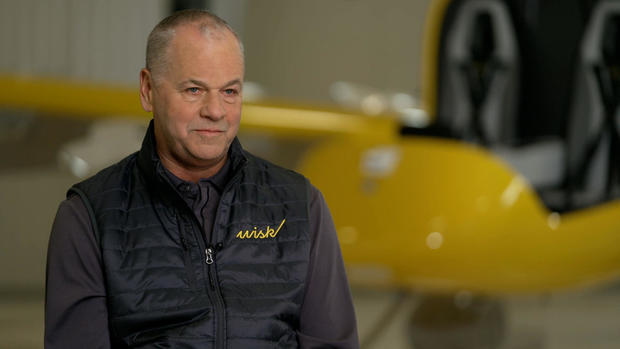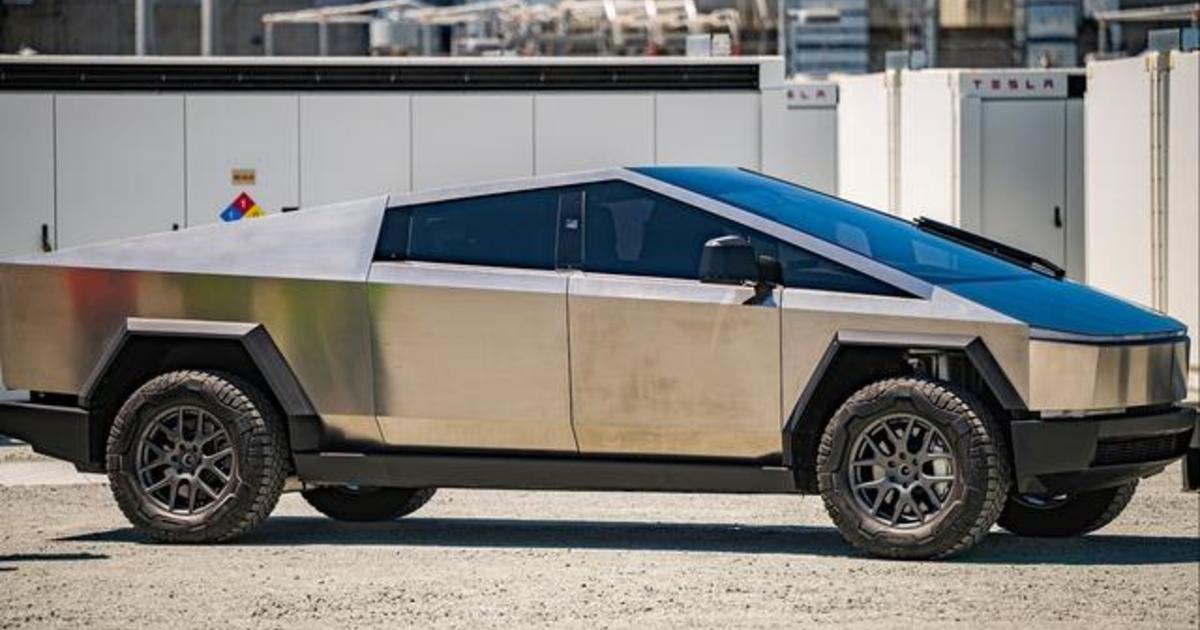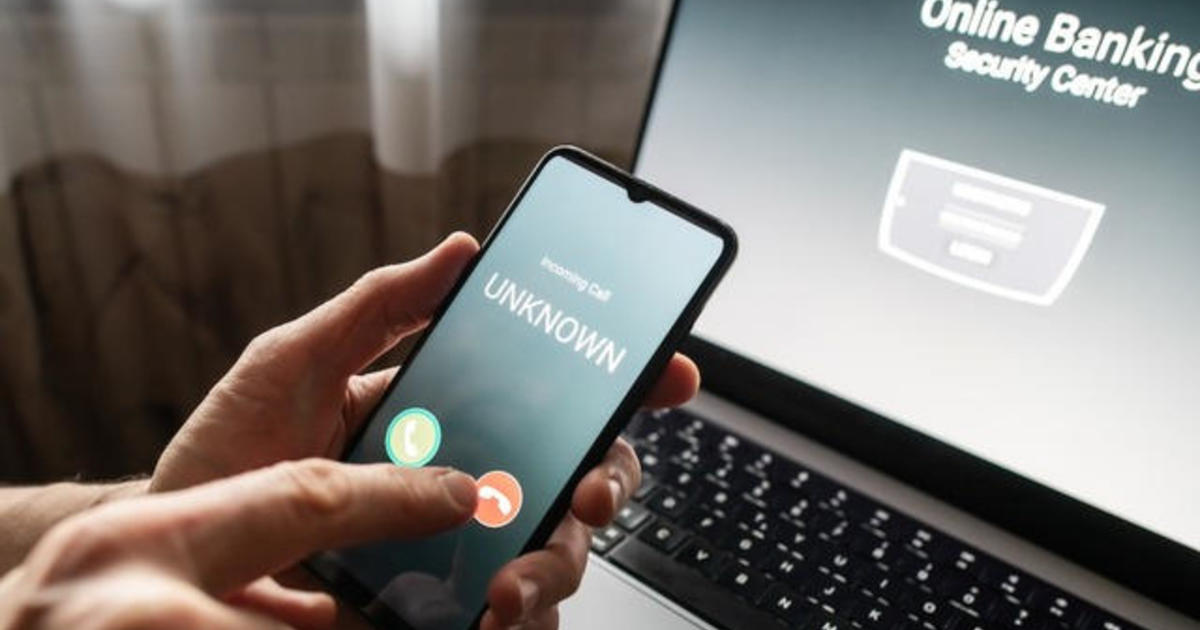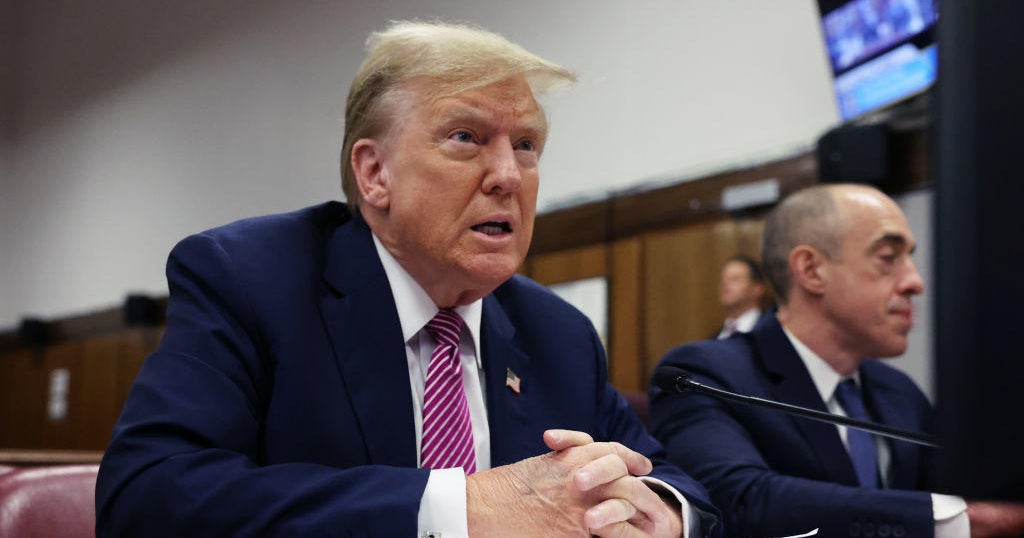eVTOL: The flying vehicles that may be the future of transportation
If you've ever had the fantasy of soaring over bumper-to-bumper traffic in a flying vehicle, that may be possible sooner than you think. Not with a flying car, but with a battery-powered aircraft called an eVTOL, a clunky acronym for electric vertical takeoff and landing vehicle. As we first reported in April, dozens of companies are spending billions of dollars to make eVTOLs that will operate like air taxis - taking off and landing from what are called vertiports on the tops of buildings, parking garages, or helipads in congested cities. EVTOLs promise a faster, safer and greener mode of transportation - potentially changing the way we work and live. Sound too good to be true? We went for a joyride to find out.
If this looks like an oversized drone I'm about to take off in, that's pretty much what it is.
It's a single-seat eVTOL called Hexa, powered by 18 propellers, each with its own battery. No jet fuel required.
Onboard computers automatically adjust for altitude and wind, so all i had to do was use a joystick to control Hexa's movement and speed. It took about 30 minutes of pre-flight training to get the hang of it.
Hexa is still in its testing phase, so I had to stay close to chief pilot Jace McCown and his ground crew. But they say it's flown up to 195 feet in the air and 24 miles per hour.
The batteries last up to 15 minutes.
To land I maneuvered Hexa into position, pressed a button and the computers did the rest.
Anderson Cooper: That is cool. I can't stop laughing.
Matt Chasen: Piece of cake, right?
Anderson Cooper: That was awesome.
Matt Chasen: Was it fun?
Anderson Cooper: That was so much fun.
Matt Chasen: Yes! I love it.
Anderson Cooper: Wow. I, so just wanna, like, take off with it.
Matt Chasen: I know.
Matt Chasen is CEO of Austin-based Lift Aircraft, which makes Hexa. He envisions a future where it's used by commuters to skip rush hour traffic.
Matt Chasen: You can fly ten miles in ten minutes instead of spending over an hour on the roads during rush hour congestion.
Anderson Cooper: Would it be something that an individual then-- in the future owns and flies from their house to somewhere?
Matt Chasen: We don't see individual ownership as very practical. These are-- these are very expensive aircraft. We see-- putting fleets of aircraft at locations, where we provide maintenance, we provide training and people can come in and basically pay per flight.
But that's still a long way off. Federal, state and local regulators - not to mention the nation's airspace - aren't ready for hundreds of thousands of commuters piloting their own eVTOLs in the skies over congested cities.
So to give people a taste of the future now, Chasen designed Hexa as an ultralight vehicle, which means it doesn't have to go through the Federal Aviation Administration's complex certification process, but also can't fly over populated areas. Chasen plans to start offering rides to paying customers for $250 by the end of this year.
Anderson Cooper: The initial market you see is essentially joy rides for people?
Matt Chasen: Yeah, I think there's a huge market for people to just experience the thrill and joy of flight.
Around the world, all kinds of eVTOL are being developed; cargo carriers, air ambulances, and a whole lot of air taxis - some with a pilot, some without. The Air Force is investing, so is Airbus and American Airlines. And dozens of companies are already working with the FAA.
Anderson Cooper: It's not the flying cars that science fiction movies anticipated?
Billy Nolen: No. But when you think about it, I-- I look back-- over the arc of my own career having been a pilot for 42 years. And I'm just amazed by the amount of innovation that has taken place.
Billy Nolen was head of safety for the FAA before being named acting administrator in March.
Anderson Cooper: How difficult a certification process is there? Because there's a lot of moving parts to this?
Billy Nolen: First, we have to certify the design of the-- of the aircraft itself. And then we look at how it will operate. Is it piloted? Is it autonomous? We look at where it will operate. So that means how do we put it within our nation's air space. So once it's met that safety threshold, and only until it's met that safety threshold, will we be-- be prepared to certify it.
Some eVTOL companies are well on their way. We flew in a gas-guzzling helicopter with one of the frontrunners in this air taxi arms race - Joeben Bevirt, CEO of Joby Aviation. He took us to this remote facility in California, where he was testing his eVTOL, the Joby Aircraft. As we landed, it felt like the old guard meeting the new.
Anderson Cooper: Obviously it's a combination of a helicopter and a plane?
Joeben Bevirt: Exactly. So it can take off like a helicopter but it flies with the efficiency of an airplane.
Bevirt has been working on the Joby for more than a decade. It has six propellers and four batteries in its wings and will operate as an air taxi, carrying a pilot and four passengers. He says it can fly 150 miles on a single charge and has a top speed of around 200 miles an hour.
Anderson Cooper: Why this design?
Joeben Bevirt: So -- vertical take off is important so it can take you to where you wanna go, right? We don't need-- a huge runway. And then-- with the wing, it gives you the efficiency to fly far and to fly fast.
Because it's still being tested, the Joby was piloted remotely by a nearby ground crew.
When they fired up the motors, unlike a helicopter, the Joby didn't need time to warm up. It took off in about 20 seconds.
Anderson Cooper: That's it? That's really quiet
Joeben Bevirt: We wanted this to sound more like the wind in the trees than the wop-wop of a helicopter.
Noise levels are a critical issue since eVTOLs are meant to take off and land near where people work and live.
Joeben Bevirt: This is below the background noise level of many cities. You know, I go around with my decibel meter on my phone and, like, measure sound levels. (LAUGH)
Anderson Cooper: That's what--
Joeben Bevirt: And-- and-- and-- and--
Anderson Cooper: --you've been doing for ten years?
Joeben Bevirt: Exactly, because we needed to make sure that the aircraft was gonna be quiet enough.
Bevirt studied mechanical engineering at Stanford, where he invented this popular flexible camera tripod and later created a company that made flying wind turbines, but the Joby had remained an elusive dream.
Joeben Bevirt: There were definitely skeptics-- even, you know, good friends of mine-- who didn't believe that you could make-- this with batteries and electric propulsion.
Anderson Cooper: The battery technology just wasn't there, it wouldn't work?
Joeben Bevirt: Yeah.
Bevirt hired Jon Wagner away from Tesla, where he helped develop the car's revolutionary batteries. At Joby, he figured out a way to make the batteries lighter, but still powerful enough to get the two-ton eVTOL off the ground.
Jon Wagner: You had to play to the strengths of battery power, and the strengths of electric motors. So a typical aircraft might have one big motor, but we can have six motors distributed throughout the aircraft, and in that way operate in a much more efficient manner.
Anderson Cooper: The weight of everything-- must be the most important thing?
Jon Wagner: Absolutely.
Anderson Cooper: So how do you make a plane as light as possible?
Jon Wagner: You essentially have to engineer every piece of it.
The outside of the Joby is made with layers of lightweight carbon fiber.
The batteries, as well as computers, electronics and motors are constructed under Jon Wagner's watch. Then his team shakes, bakes and spins them to ensure they'll meet the FAA's rigorous safety standards.
Anderson Cooper: They have to certify the aircraft as being safe and capable of flying to their standards, they also have to certify the production of all the parts of it?
Joeben Bevirt: Exactly, the operation, the pilot training, the maintenance-- steps, every facet is heavily regulated.
All this costs a lot of money. Toyota has invested about $400 million in Joby, and Bevirt took the company public last year.
Billionaire Paul Sciarra, co-founder of the website pinterest, has also put in a small fortune. He's Joby's executive chairman and says they'll launch in up to three cities, and that passengers will eventually end up paying around three to four dollars a mile to fly - a little more than an average Uber ride.
Anderson Cooper: Can you just take me through, as a passenger, what it looks like? I wanna get to JFK Airport-- it's bumper to bumper traffic. What do I do?
Paul Sciarra: Take out your phone, pull out an app. And with one click you're booking the whole trip. So a car is coming to wherever you are in Manhattan, it's taking you to the take-off and landing location, the vertiport. And you're hopping in your Joby and it's flying you to your final destination. Now, maybe there's a car at the other end or you're just walking to the tail end.
Anderson Cooper: If people are taking cars to and from Vertiports-- doesn't that just add to congestion?
Paul Sciarra: If we're able to, you know, take out 80% of the miles-- that people might be traveling and move those miles from congested roads to the air, I think that's gonna have an impact.
But just a few weeks after we saw this Joby aircraft fly, it crashed in February due to what federal investigators called a component failure. No one was hurt, but the eVTOL was totaled. Bevirt says that's all part of the testing process and is as optimistic now as he was when we interviewed him.
Anderson Cooper: How far are you from getting the first Joby in the sky with passengers?
Joeben Bevirt: So we are launching our service in 2024.
Anderson Cooper: You think you can do it that quickly?
Joeben Bevirt: Yes.
Anderson Cooper: There have been, though, a lot of companies that have said, "Oh, we're gonna do this in two years" and then it doesn't happen.
Joeben Bevirt: We're very confident.
There's a lot of confidence over at Wisk Aero as well, though the eVTOL they are developing will be even more complicated to bring to market because it's fully-autonomous. There will be passengers, but no pilot on board.
Anderson Cooper: You're not just figuring out an electric vehicle. You're f-- figuring out a fully autonomous, flying--
Gary Gysin: That's right.
Anderson Cooper: --vehicle?
Gary Gysin: That's right. We're goin' for it. (LAUGH)
CEO Gary Gysin says they're on track to spend about $2 billion. The company is bankrolled by Boeing and Google cofounder Larry Page. They've been testing the technology for the last eight years.
Anderson Cooper: So, how many test flights have you actually done?
Gary Gysin: So, close-- close to 1,600 test flights without, you know-- knock on wood, without an incident.
We watched one of those test flights in Hollister, California. A team of engineers about half a mile away started the eVTOL with the click of a mouse. The entire route was pre-programmed.
Anderson Cooper: Why autonomous? Why go this route?
Gary Gysin: Yeah. So, we're going straight to self-flying. Several reasons. One, it's safer.
Safer, he says, because most plane accidents involve human error. Much of commercial aviation is already automated and Gysin sees the entire eVTOL industry going that way eventually. He is determined to get there first.
Gary Gysin: We do it primarily from a safety perspective but also scale. So, if you don't have a pilot in the aircraft, it's less expensive. You don't have to do pilot training. You're flying four passengers. We can charge less. We don't want this to be a premium helicopter-like service. We want this to be a service that's affordable to the masses.
Anderson Cooper: There is a hurdle psychologically for people to get into an aircraft that does not have a human at the controls.
Gary Gysin: Of course. And so what we're trying to do with that is each passenger can be in-- verbal communication with the ground. They can be talking to a pilot whenever they want to. So it's all designed to provide comfort. It will take time. This isn't gonna happen overnight.
Gysin wants to launch Wisk's four-seater air taxi service in the world's 20 busiest cities within the next decade.
Anderson Cooper: You don't give a date of when you think you'll be operational?
Gary Gysin: Yeah, you know why we don't do that? Because we are not in control of that part. The FAA is. In Europe, it's called EASA. They're in charge. So when they certify aircraft to fly, that's when you fly.
The FAA won't say when an autonomous evtol might be certified, but acting administrator Billy Nolen told us hailing a piloted air taxi by 2024 is well within the realm of possibility.
Billy Nolen: The challenge for us is to make sure that innovation doesn't come at the expense of safety. But clearly, we are seeing the emergence of-- something that's fantastic I think.
Anderson Cooper: This is real? I mean, this is no longer just the stuff of fantasy?
Billy Nolen: We want to be very careful. We want to be very measured. But you're absolutely right. This is real. And this is happening. We've come a long way from where we were just, you know, a mere decade ago.
Produced by Nichole Marks. Associate producers, Emily Cameron and David M. Levine. Broadcast associate, Annabelle Hanflig. Edited by Michael Mongulla.
